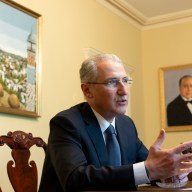You don’t maintain a 40-year career in the music business without reinventing yourself every once in a while. Former Led Zeppelin frontman Robert Plant is the most recent rock veteran to undergo a seemingly effortless transition into another successful phase of his career, with his second bluegrass flavored album, “Band of Joy.” Here we look at the drastic changes he’s made throughout his tenure in the music industry and the drastic changes of some of his peers.
The artists
Robert Plant
First contact: As the singer for Led Zeppelin in the ’60s and ’70s, Plant and pals basically define how hard rock should sound.
First change: After Zep’s breakup in 1980, Plant made a string of solo albums with a decidedly modern feel, eschewing the emphasis on guitars that made his band such a hit.
Big surprise: Plant’s 1985 EP with the Honeydrippers was ’50s covers. The song “Sea of Love” became his biggest hit, which reportedly upset the singer, as he feared he’d be known for this style.
New horizons: “Raising Sand,” Plant’s first foray into bluegrass with singer Ali-son Kraus, is a commercial success and wins the Album of the Year Grammy in 2009. This halts any plans of a Zep reunion tour.
Bob Dylan
First contact: Arriving on the scene in 1962, Dylan’s poetic original lyrics and folk guitar accompaniment make him a hero to a generation of aspiring folkies.
First change: In 1965, Dylan is ready for his times to be a-changin’ — he plays an electric guitar at the Newport Folk Festival, upsetting many fans.
Big surprise: Three-way tie between 1969’s country-tinged “Nashville Skyline,” his 1979 born-again Christian LP, “Slow Train Coming” and 2009’s “Christmas in the Heart.”
New horizons: Dylan continues to tour and release albums. As anybody who has witnessed him live or listened to his latest releases will tell you, both pursuits are of varying quality.
Neil Young
First contact: In the ’60s, Young established himself as a solo artist, a guitarist for Buffalo Springfield and a collaborator with Crosby, Stills and Nash.
First change: Singing in an electronic voice against synthesizers, 1982’s “Trans” album didn’t sound like anything he’d done before.
Big surprise: His follow-up, “Everybody’s Rockin’,” was all rockabilly tunes; it was so un-Neil Young that his label sued him for making music unrepresentative of himself.
New horizons: As grunge became popular in the ’90s, Young was cited as a major inspiration. It seemed to help him reclaim his past, while experimenting further.
David Bowie
First contact: Bowie’s 1969 ode to astronauts, “Space Oddity,” laid the groundwork that this was one weird artist worth watching. For 40 years, he has not disappointed.
First change: One of his first ch-ch-ch-changes was his invention of the alter-ego persona Ziggy Stardust, whom he used to dress up as throughout the early ’70s.
Big surprise: After a decade of artsy reinventions and experiments, in the ’80s Bowie resurfaced with “Let’s Dance,” a slick pop look and sound.
New horizons: Bowie has continued to push boundaries, dabbling in noise rock and electronica with good results. However, he hasn’t released an album of new material since 2003’s “Reality.”













